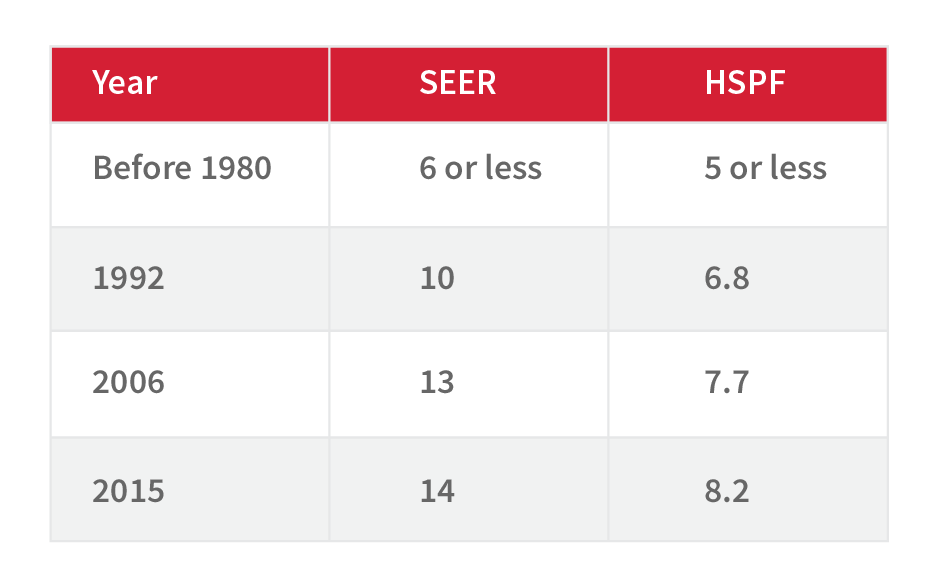What Generation is Your Heat Pump?

World events and trends tend to shape generations. What happens during your formative years may often change your behaviors and expectations as an adult. Chances are if you had a heat pump installed in 2007, you didn’t expect it to be “smart.” In reality, the 2007 model may not have been too different from the one you grew up with. A heat pump’s main function was and still is to heat and cool the indoor spaces in your home.
Whether you are a Baby Boomer (born: 1946 to 1964), Generation X (born: 1965-1980), or a Millennial (born: 1981-1997), there is a good chance that your latest home heating and cooling equipment was manufactured and installed in the iGeneration (1998 to present). Yet, a heat pump that was designed and engineered in 2007 will probably not have the same performance features and characteristics of one that was built in 2017!
As more and more homeowners are expecting the latest innovative technology to be incorporated into new products for their home and personal use, heating and cooling manufacturers are responding too
Heat Pump Efficiency by Generation
By the late 1960s, when the first Generation X babies were born, most new homes in North America had central air conditioning. It wasn’t until the oil crisis of the 1970s that the heat pump became a more popular choice for heating and cooling homes. Heat pumps used a single ‘fuel’, electricity, to heat and cool a home.
Many Generation X’ers were children at the time of the oil crisis in the 70’s, witnesses to its impacts. Before 1980, many heat pumps had a Seasonal Energy Efficiency Rating (SEER) of 6 or less and a Heating Seasonal Performance Factor (HSPF) below 5. By 1992, when the first of Generation X’ers were entering the workforce, the U.S. Department of Energy (DOE) raised the minimum SEER of heat pumps to 10 SEER/ 6.8 HSPF. The energy conservation movement was in full swing, and the push by Generation X’ers for more energy-efficient products was evident.
By 2006, the average Millennial was in high school, and the DOE raised the minimum SEER requirement from 10 SEER/6.8 HSPF to 13 SEER/7.7 HSPF nationwide. Efficiency to conserve energy and minimize consumer’s impact on the environment appeared to be an actionable priority.
In 2015, the Millennials became the largest sector in the U.S. labor force, and the DOE once again raised the minimum SEER requirement for heat pumps. The minimum standard now stands at 14 SEER/8.2 HSPF, but residential efficiency requirements are likely to continue increasing in the future. There is already a push to increase the current standard to 15 SEER by 2023.
So, if your heat pump was installed in the iGeneration, its efficiency rating could range anywhere between 10-14 SEER and 6.8-8.2 HSPF!
Innovative Technology and Heat Pump Efficiency
Today’s heat pumps are vastly different from the early models from the 1970s and '80s. Innovative technology created by recent generations has played a big role in the transformation, effectiveness, popularity and energy efficiency of these heating and cooling systems.
Air source heat pumps that have typically been reserved as a heating and cooling option for homes in milder climates are working their way north! Innovative advances in heat pump technology have created a legitimate heating alternative for colder regions where temperatures drop to below freezing. Millennials who grew up in these colder areas may have rarely experienced heat from a heat pump because it wasn’t a comfortable option. However, today’s heat pumps are now being installed from Alaska to Florida.
Some models of heat pumps are now equipped with variable-speed or dual-speed motors on their indoor fans (blowers), outdoor fans, or both. “The variable-speed controls for these fans attempt to keep the air moving at a comfortable velocity, minimizing cool drafts and maximizing electrical savings.” Additional advancements, including refrigerant, advanced controls and additional mechanics that simplify installation, have also impacted the indoor comfort and energy costs associated with heat pumps.
The heat pumps of today are likely not the same as your parent’s heat pump!
How Smart is your Heat Pump?
As we know, product technology is advancing at breakneck speed! The smart phone is changing the behavior of many Generation Xers and Millennials, and even some Baby Boomers. Just a few years ago, the term “smart home” didn’t exist. Yet, the increased availability and reduced cost of smart products have created a smart home marketplace boom. Tech savvy homeowners are increasingly looking for ways to connect this technology to their home systems…and heating and cooling manufacturers are taking notice.
Innovative thermostats or control systems now offer a wide range of control features and connectivity with your smart phone and the Internet. This makes it easier to align your heat pump operation with your lifestyle. But as history has shown, current events dictate future expectations. What will a heat pump look like for the kids that never experienced life without a smart phone? Will their expectations of “normal” extend to home heating and cooling?
As technology continues to become more integrated into the heating and cooling equipment, some heat pumps may be able to communicate status updates directly to the homeowner or your HVAC dealer. In the future, the technician or dealer may be able to contact the homeowner regarding the notification, arrive at their home with the correct part(s) and be sure the HVAC system is maintained without the homeowner having to lift a finger or experience an uncomfortable temperature in their home.
This technology could allow for proactive maintenance or service scheduling, possibly before you realize that it’s necessary. But before this becomes a standard heat pump feature, consumers need to demonstrate their expectations. As with generations before them, the events and trends of today’s youth may impact future behaviors and heating and cooling products.



